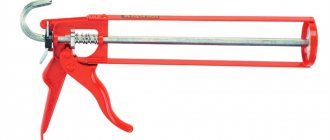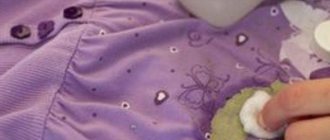Device design
Diamond glass cutter is based on the following parts:
- Pen. It is made taking into account the ease of use of the tool, so it has a teardrop shape. It is made from various materials: wood, polystyrene or phenolic.
- Kernel. Performs the function of a frame. It looks like a brass or steel tube, which is coated with a protective anti-corrosion coating on top.
- Hammer. Made from durable grades of brass or steel. It has the shape of a truncated diamond and is located at the very edge of the instrument. The hammer has special slots that simplify the process of breaking off glass or mirror along the cut line.
One diamond glass cutting stone should be enough for 11.5 km of sheet glass, the diameter of which is 5 ml.
Brick cutting
Brick is a common material in construction. It often needs to be adjusted to size when carrying out repair work at home. At the same time, cutting bricks with a grinder is a very common operation. To carry it out, you will need, in addition to working power tools with cutting discs, the following devices:
- construction pencil or chalk;
- ruler and square.
The entire process of cutting brick blocks is accompanied by significant dust formation, so care should be taken to protect the respiratory system and eyes from dust. To do this, you should use goggles and a respirator, or a solid mask. Hands must be protected with gloves.
The cutting process itself consists of several stages:
- drawing marking lines with chalk or pencil using a ruler or square;
- cutting a brick, in which the circle must pass near the marked line to ensure the required size of the block fragment.
It is recommended to place a board under the brick to be sawed to make working more convenient and not damage the flooring. When cutting a brick block, you do not need to apply pressure to the power tool. A little effort is enough. When work is carried out using circles of insufficient diameter for complete sawing, the cut is made along the marked perimeter. The excess is beaten off with a hammer and then polished.
Labor efficiency and the quality of the final result can be increased by using a special bed. It allows you to securely secure the grinder and the brick block. At the same time, it becomes possible to saw the brick not only lengthwise or crosswise, but also at various angles. This installation is shown in the following photo.
To saw a brick straight away without turning it over, you should use circles with a disk diameter of 230 mm. It is easier to process cut areas if the nozzle size is 125 mm. If you cut blocks with such a relatively small disk, the quality of the result will largely be determined by the skill of the carver. The time it takes to complete the work will also increase and labor productivity will decrease.
Varieties
To choose the right working tool, you need to know that there are 2 types of diamond glass cutters:
- The diamond glass cutter, which is mounted on a square holder, is made in the shape of a 4-sided pyramid.
- A diamond tool mounted on a round holder, shaped like a curved chip.
The first type is suitable for those who have already encountered the work of cutting glass and have some experience in this industry. The cutter in such a glass cutter is installed at a certain angle (200-220° relative to the axis of the tool). There is a special marking on the cutter that shows the orientation of the working edge. If, when working with such a diamond glass cutter, the hand is at an incorrect angle, this will lead to damage to the working blade. The line drawn by the diamond stone should be thin and without excessive dust. When the working face of the diamond pyramid has exhausted its working life, it is necessary to change the orientation of the stone according to the markings indicated on the cutter.
The curved chipped diamond, which is equipped with 2 types of glass cutters, is easier to use, since the chip is in the same plane with the main axis of the tool. This type of glass cutter is recommended to be used by beginning glaziers or purchased by those people who need a glass cutter for single use cases.
The size of the cutting diamond stone is selected according to the thickness of the working blade. For glass with a thickness of 6-10 mm, a stone with a size of 0.11-0.16 carats is used, for glass with a thickness of 2 to 5 mm - 0.02-0.10 carats.
Preparatory work
To properly cut glass at home, you need to have the appropriate tools and a place to process it.
Necessary tool
To work, a home craftsman will need a minimum set of:
- glass cutter, maybe an old-fashioned design or a more modern one with a container for lubricating the roller with kerosene;
- marker for marking glass blanks;
- construction square, providing control of right angles;
- ruler for marking and orienting the cutting line.
At the stage of marking the workpiece for cutting grooves, it is necessary to maintain dimensional accuracy: the width of the working head of the glass cutter should be taken into account. It is 5 mm, and the axis of the cutting roller deviates from its side edge by half this value.
When choosing a ruler, pay attention to its thickness. Thin and pointed side edges are not suitable
The glass cutter head will not move well along them.
When placing the ruler on the glass, from its edge to the axis of the roller, it is necessary to create an indent of 2.5 mm.
For such work, it is convenient to use a piece of laminate or a flat strip. To prevent such a template from slipping off the surface of the glass when cutting, cloth or fabric tape is glued to its bottom side.
Workplace
Glass does not withstand local lateral loads well. The pressure from the glass cutter is what causes them. Therefore, a home craftsman should work with glass only on a prepared, clean and level surface.
A coating made from a solid sheet of fiberboard and similar materials is well suited. It is perfectly acceptable to cover a regular table with a blanket and cut on it.
What to prepare for work?
Before you start cutting a mirror for your home interior, it is important to make sure that everything you need is at hand. These are tools, accessories, items for cleaning up after yourself, as well as for observing safety precautions, because when working with glass, caution should come first.
To work you will need:
- the mirror itself;
- glass cutter;
- flat, smooth surface (wide table or large chipboard);
- a long thick ruler (about 8 mm thick);
- a piece of fabric (for example, a sheet or an old tablecloth);
- pliers with rubber gaskets;
- small hammer;
- roulette;
- fine sandpaper;
- bowl or basin with water;
- rag;
- soda and alcohol;
- pencil, chalk or marker for marking glass.
To keep your hands and eyes safe, you need to prepare:
- thick fabric gloves (to avoid cutting your fingers);
- patch for additional finger protection;
- safety glasses (construction, cycling or any other).
Other necessary tools and materials
Mirror pieces can only be cut at a prepared workplace. To do this, take a table; its surface should be large enough and flat. The mirror will lie completely on the tabletop, so its size is appropriate. Before starting, cover the work area with a soft cloth. At home, they often use an old sheet or tablecloth. The ruler and square should be thick and long; it is advisable that they be specially designed for cutting glass. In addition, pliers with rubber pads, a tape measure and a small hammer will come in handy. Place a wooden box or a box made of thick cardboard under the debris and scraps.
During the cutting process and preparation for it, the following consumables will be used: rags, alcohol and soda, chalk or marker. Instead of the latter, glass pencils are sometimes purchased for marking. For figure cutting, patterns are made in advance.
Principle of glass cutting technology
Here's how to properly cut a mirror with a glass cutter at home:
- First you need to prepare the mirror surface and tools.
- After this, mark using a ruler and marker. For the figured version, use special patterns.
- Then carefully draw a line with a glass cutter, maintaining constant pressure.
- Then very carefully tap with a hammer, through several layers of fabric, the edge of the mirror that will need to be removed. Before this, it is slightly hung from the edge of the table, always supported in such a way that the mirror or glass does not fall to the floor.
- After this, the work is carried out on a break. That is, they try, by applying little effort, to break off an unnecessary piece from the base. Then wipe the cut edge with a damp cloth, which was previously folded in several layers. This is done in order to remove small particles of glass.
Take advice from a professional when cutting mirrors.
What kind of glass cutter should I use?
For a non-professional, it makes no difference what kind of glass cutters there are, so most often those that are cheaper are bought “for one time”. However, this is not always justified.
To cut a mirror, you can use different types of glass cutters. The most popular are roller and diamond. The second one costs much more, but it is much easier to work with, less effort is required, the quality of the cuts will be much higher, and the amount of scrap and waste will be less.
It is optimal, of course, to cut the mirror with a diamond glass cutter. Especially if the work planned is quite delicate and precise or there is a large volume to be completed. A diamond nose is inserted into the frame of such a glass cutter (hence, in fact, the name), which has acute and obtuse angles
During the cutting process, it is important to move the sharp angle forward, then the tool will move along the surface freely, without “stumbling” over the smallest surface irregularities. If you cut at an obtuse angle, the grain of the glass cutter will either jump out of its socket or “go off course”
In order to maintain the same angle of inclination of the tool when working, it is important to always point the mark on the frame of the glass cutter towards the ruler.
A roller glass cutter is more difficult to hold a line, and to obtain a high-quality cut you need to put in much more effort. In order to facilitate the sliding of such a tool over the surface, the line of the future cut can be lubricated with turpentine, using, for example, a student’s paint brush.
Tips for the final stage
- First, practice on unwanted pieces of mirror.
- If the cut lines are straight, for example for a square mirror, place it on a flat surface so that the cut extends just a little beyond the edge of the table. Press down on the canvas, hold it with one hand, and press down on the free edge with the other hand. This will give you a clean break.
- If the figure requires minor cutting, use a cutter with a steel ring.
- If you need to separate the canvas along the wavy cuts, turn the mirror over, place it on foam plastic, cardboard or any other springy surface, press on the lines with your index finger, then the cut should split.
Once the mirror is detached, you can either frame it or sand the edge with fine-grain paper. This way you will avoid accidental cuts.
Don’t be afraid to cut a mirror at home, the main thing is to do everything carefully and thoughtfully!
How to cut glass without a glass cutter
Tools for cutting glass were not always as widespread as they are today. In the second half of the last century, people came up with their own ways to conquer this capricious material, without using a glass cutter. In fact, to cut non-tempered glass up to 8 mm thick, you can use many available items, you just need to have a little skill. It is better to start listing items suitable for working with glass by identifying the types of impact on this material. The main methods include thermal, when glass is heated in a certain place, and physical, when it is cut by brute force. The industry uses a waterjet cutting method, when glass is processed using expensive equipment under strong water pressure.
To cut glass using the thermal method, all you need is a small piece of string and a flammable liquid like alcohol or acetone; a soldering iron and a burning apparatus can also be used as a cutter. To cut glass by physical force, you can use a file, a pobedit drill, a nail, a thin diamond disk, and even ordinary tailor's scissors. Of course, some of the listed items are difficult to get a good chip, but with the right skill, a quite suitable result can come out. Now, knowing how you can cut glass without a glass cutter, you can move on to the process itself.
Nuances and recommendations of the masters
- The functionality of the tongs and the glass cutter-roller is combined with the tile cutter-tongs. It is suitable for processing the most difficult types of tiles.
- An oil tile cutter requires filling the container no more than a third full. To cut a limited number of ceramic products, simply dip the roller into a container of lubricant.
- Tiles intended for sawing must be free of dust and dirt. This will help maintain the trajectory of the glass cutter.
- If it was not possible to cut through the tile the first time, you need to return 2-3 mm from the place of separation and continue to draw the line.
- At the beginning and end of the outlined cutting line, use the glass cutter with less pressure to avoid splitting.
- Beginners should use lightweight glass cutters with wooden handles.
Using a glass cutter to cut tiles is justified at home. The method is considered acceptable only for thin wall tiles. To work with more durable materials, it would be advisable to use a power tool.
What tools to use?
Many of us are accustomed to thinking that glass can only be cut correctly and efficiently with a glass cutter. But what to do if you need to cut a piece of glass urgently, but you don’t have this tool at hand? There is another unusual, but no less effective method that helped our great-grandfathers get out of this situation. Such a tool is ordinary scissors, available to any owner. Let's look at each method in detail.
Option 1: glass cutter
The technology for cutting glass with a glass cutter is quite simple. To do this, you must comply with certain conditions and choose the right glass cutter. Today, the choice of this tool is quite wide, which allows you to turn work into pleasure.
- Diamond glass cutter, time-tested and remains a leader in its field to this day. Glass cutters with a beveled cutting edge are suitable for home use. This tool is designed to cut glass up to ten kilometers and is suitable for any thickness of the material used. From time to time, such a glass cutter needs to be sharpened on a special whetstone.
- Roller. As the name suggests, the cutting part of such a glass cutter is made in the form of a roller made of a durable cobalt-tungsten alloy. The number of rollers can be from one to six.
- Oil. This tool works on the principle of a roller glass cutter, with the difference that a reservoir with oil is built into its handle, which is automatically supplied to the roller. Suitable for cutting thick glass.
To learn how to choose a good glass cutter, watch the video:
So, having dealt with the glass cutter, place the glass on a flat surface. Mark the glass and get to work. To make the task easier, you can use a ruler. It is worth considering the point that the line must be drawn the first time, otherwise a repeated attempt will lead to cracking of the surface. When cutting glass with a glass cutter, you need to apply equal force along the entire length of the line.
Option 2: ordinary scissors
Cutting glass with scissors like paper is not a fairy tale, but a completely everyday reality. For this purpose, you will need the scissors themselves (sewing scissors are best for this) and a tank of water (preferably hot). It is necessary to apply markings on the glass in advance, and then elementary physics comes into play: scissors create a microcrack, and the capillary effect completes the process. Of course, the result obtained will differ from that achieved with a glass cutter, but if necessary, this method can help out significantly.
Instructions for using a glass cutter
Let's figure out how to cut glass with a glass cutter at home. For convenience, we will divide the entire work process into several stages.
Preparatory activities
Such events influence a lot. Preparation depends primarily on the glass you choose to cut. The purchased material should be wiped from dust using an old newspaper so that no streaks or lint remain on the surface. Used glass requires more thorough preparation. First, you should wash it using special products. After this, the surface is degreased, the glass is dried in a closed room so that dust does not settle on its surface.
Cut glass
Many people also refer this process to the preparatory stage, but we will highlight it as an independent type of work. It is no secret that there is no absolutely waste-free production for this type of work, especially if the ultimate goal is to obtain a product with unusual geometric parameters. But if you first calculate and outline how to cut glass with a glass cutter, you can minimize waste. Experts recommend combining the longest side of the glass with the long edge of the workpiece. At the same time, you should not rush to throw away the remaining trimmings - they may be useful in the future.
Cutting technique
All that remains is to find out how to properly cut glass with a glass cutter. To do this you will need a flat surface. To prevent small glass fragments and other debris from disturbing us, the table is covered with soft material, the thickness of which reaches 3–5 mm.
Now - attention! Only one cut is made - it is prohibited to use a glass cutter in one place a second time.
If the tool is roller, more pressure is exerted on it than on a diamond tool. Correct cutting is accompanied by a characteristic crunch. Closer to the edge of the glass, the pressure weakens so that there is no chipping and the cutting edge of the tool is not damaged. After this, a flat strip is placed under the glass, and a break is made along the cutting line. It is recommended to first tap the line with the handle of a glass cutter to deepen the cracks and facilitate the breaking process. If you need to break off a narrow strip, you can use pliers or a glass cutter handle that has special grooves.
Is it possible to cut glass without a glass cutter at home?
Not everyone knows that ordinary glass can be cut using the most common scissors. The main conditions in this case are sharp - sharpening the cutting edge. In this case, it is necessary to place all the glass in a container large enough so that it is covered with water.
Sometimes there is a desire to purchase a mirror of some intricate shape.
It is the liquid that prevents chips and cracks from appearing. Then, carefully start cutting small pieces with scissors, achieving the desired shape and size.
Cut the mirror into any shape.
Note! This option for processing a mirror is suitable only if its thickness does not exceed the 4 mm mark and it is necessary to perform figured cutting. Most likely, cutting a straight line will not work in this case.
You can use another method. For example, take a file that has a rectangular or triangular shaped cutting edge.
The cutting element must be located strictly on the marked line and perpendicular to the surface of the mirror.
The technology of action in this case is as follows: with the edge of a file, cuts are made on both sides. Then the main line is scratched and breaking off is carried out. But to implement this option, you need skill in working with materials such as glass and mirror.
If you have never worked with a mirror, then ask for help.
You can also try using a pobedit drill. Here holes are made in several places. They all lie on the cutting line. After which a thin line is scratched between them and the unnecessary part is removed by tapping and breaking off.
If everything is done correctly, you can hear the sound of glass being cut, and it is impossible to confuse it.
Important! If work is carried out with a drill, then it must be turned so that only an acute angle enters the glass. Otherwise the mirror will crack.
You can cut the mirror yourself.
Considering all these features, it is quite easy to trim or shape a mirror at home.
Which glass cutter to use
To work, first of all you will need tools: a large table with a flat surface, a ruler and a square for cutting glass and, of course, a glass cutter. The quality of future work largely depends on the choice of the latter.
The tool market offers a wide selection of different models, satisfying the needs of amateur craftsmen and specialists of all levels. Several questions naturally arise before us. First, you need to decide which type of glass cutter is best suited for cutting mirrors at home. The choice is largely determined by the person who will do the cutting. If this is an experienced craftsman who is accustomed to working with a diamond glass cutter, then it is reasonable to continue to use it in this situation. Such a tool is more expensive, but in the hands of a professional it gives a more even and high-quality cut.
These models have a lower cost and are easier to use for beginners.
The thickness of the mirror must also be taken into account. Most mirrors produced in Russia are from 2 to 6 mm; any device can handle them, but cutting thicker samples will not be possible with a regular roller glass cutter; you will need an oil or diamond tool.
Let's start cutting
The glass cutter should be positioned at right angles to the mirror surface strictly on the marked line. Pressing it slightly against the glass, it must be carefully guided in the direction leading to you. Do not hurry. Move the glass cutter gently and precisely along the marked line. If you hear the sound of glass being cut, then everything is going well. A squeak indicates that the glass cutter is broken or you are doing something wrong.
Special glass liquids will help you wash an old mirror.
When cut correctly, you will see a thin line on the glass. If all goes well, place the mirror on the workbench so that the line extends slightly beyond the edge. Then press lightly on the cut part, holding the other one with your other hand. The glass should fall off. If this does not happen, tap the entire line from the bottom side with a hammer, moving it towards you. Does not work? Repeat the cutting procedure again. Small fragments are removed using pliers.
If you have just purchased a mirror, you need to leave it for a couple of hours in the room where the entire cutting process will take place.
A squeak indicates that the glass cutter is broken or you are doing something wrong.
Let's move on to accurate glass cutting
To achieve the desired result, just follow simple rules:
- For stability and correct position of the glass cutter, we attach pieces of rubber to the ends of the ruler or strip (you can use a regular eraser)
- into diamond glass cutter at an acute angle to the surface. roller glass cutter with turpentine or kerosene. If you have an oil glass cutter, you don’t need to do anything.
- We make marks on the mirror. Then, we apply the ruler to the surface, and with an even, calm movement we draw a line perpendicular to the mirror, weakening this movement at the very edge. There is no need to press hard; if you notice a white, thin and even line, it means everything was done correctly. When cutting with a diamond glass cutter, the line will be slightly visible. There should be no creaking or thick lines. The thinner the mirror, the sharper the sharpening angle of the selected roller should be.
- We move the mirror to the edge of the table, pressing it with one hand, and with the other we press it with a sharp, but not very strong, downward movement. The chipped part should fall off, but if this does not happen, then use pliers, having previously wrapped the edges with electrical tape, or go from top to bottom with a hammer, gently tapping along the entire line.
- We treat the edge with sealant or clear nail polish.
When cutting glass, you must use gloves and safety glasses to avoid damaging your hands and eyes.
If something goes wrong, try making a cut nearby, stepping back a couple of millimeters. There shouldn't be any pieces of glass or crumbs either. And when cutting, a characteristic cracking sound should be heard.
Practice before cutting on regular glass or pieces of unnecessary mirrors - if everything works out, don’t be afraid to do it with a large mirror. A prerequisite is that it should not be too thick.
Safety precautions when cutting mirrors
Cutting mirrors, like any other type of production activity, poses a significant threat to human health if it is treated carelessly and safety precautions are violated. The main threat is glass fragments, which can cut into the master’s hands or get into the eyes.
General safety requirements when cutting glass are as follows:
Before starting work, wear safety glasses and gloves. It is important that glasses should not reduce visibility.
It is better to take rubberized gloves. Provide a special box for scraps so that they are not in the work area and are not scattered on the floor. The waste is removed from the box carefully; it is better to chop off the cracked pieces and remove them piece by piece. To cut a mirror you need a normal table. Using a workplace assembled from improvised things can lead to unpleasant consequences. After work, the tabletop is wiped down, and the floor around the workplace is thoroughly swept. It is worth cutting glass in compliance with all aspects of technology. Innovations on your own are unacceptable.
Precautionary measures
Safety precautions are of great importance when cutting mirrors at home. Compliance with this will save you from possible injuries and help you avoid damaging the mirror during work.
To ensure complete safety you will need:
- create ideal order in the future workplace, remove everything unnecessary, arrange waste containers and tools required for work so that they are freely accessible;
- Before starting work, you need to make sure that the glass cutter and pliers are in good condition;
- the cutting process should be started in a calm state, without excitement, all movements should be smooth, sudden movements should be avoided;
- to avoid cuts, do not touch the edges of the glass with your hands without protective equipment;
- Do not cut mirrors on unsuitable surfaces;
- if work is carried out high above the ground, it is strictly forbidden to throw the trimmings down, they must be taken with you;
- When removing pieces of mirrors, care should be taken: if they are cracked, you need to take only one fragment at a time;
- when moving a mirror from a room with a low temperature to a warm one, you need to give it time to warm up;
- dust and crumbs remaining after cutting must be removed with a special brush; under no circumstances should they be blown away;
- If you were wearing overalls, you need to thoroughly shake them off before taking them off.
Alternative options
Agree that not everyone has glass cutters. Therefore, many go in search of alternative options so as not to spend extra money on the purchase of special tools.
On the Internet you can find many videos in which glass and mirrors are cut with all kinds of improvised means.
I want to tell you about several original and simply effective ways to replace a glass cutter and cope with the task.
- Tile cutter. If available, you can process a fairly thick mirror sheet with a tile cutter. But again, the tool is not cheap. If you choose, it is better to buy a diamond-type glass cutter;
The options are truly varied. Moreover, all of them are tested in practice and have proven efficiency and performance.
Other necessary tools and materials
Mirror pieces can only be cut at a prepared workplace. To do this, take a table; its surface should be large enough and flat. The mirror will lie completely on the tabletop, so its size is appropriate. Before starting, cover the work area with a soft cloth. At home, they often use an old sheet or tablecloth. The ruler and square should be thick and long; it is advisable that they be specially designed for cutting glass. In addition, pliers with rubber pads, a tape measure and a small hammer will come in handy. Place a wooden box or a box made of thick cardboard under the debris and scraps.
During the cutting process and preparation for it, the following consumables will be used: rags, alcohol and soda, chalk or marker. Instead of the latter, glass pencils are sometimes purchased for marking. For figure cutting, patterns are made in advance.
Mirror Surface Cutting Tools
- Glass cutter (diamond or roller);
- small hammer;
- a long metal ruler, or a strip of hard material, no thicker than 1 cm;
- pliers;
- a table with a thick cloth spread on it (I used a large linen tablecloth, folded several times)
- mirror sealant or clear nail polish;
- glass cleaner or alcohol.
Read also: At what temperature does soldering solder melt?
Shaped cutting of mirrors
The cutting technology is similar. The only difference is that you need to make a pattern.
The main difference is in the breaking procedure. Break off unnecessary sections in parts, dividing them into sections with more or less equal shares according to the degree of curvature or angles of inclination to the straight line. To facilitate breaking, additional lines are manually drawn with a glass cutter from the maximum and minimum of the curve to the outer edge. Circles or ovals are simply divided into a number of segments.
Shaped cutting of mirrors
Safety
All operations must be carried out wearing work gloves. It is usually recommended to choose them from latex, but it is quite sufficient to use cotton ones with a protective working layer.
After cutting the mirror, its edges are treated with fine-grained sandpaper.
Noteworthy information: How to drill glass, How to glue glass to glass
mirror cutting
Watch this video on YouTube
Shaped cutting of mirrors to order, https://www.steklo-zerkalo.com/zerkalo/
Watch this video on YouTube
Figured mirrors - features and tips for cutting
Once, I had the opportunity to make an oval-shaped mirror. The task has become a little more complicated, but not much - the main thing is to make a pattern and attach it to the surface. In hardware stores you can find compasses-like glass cutters for shaped cutting with a suction cup and a scale for installation. They are undoubtedly more convenient to use, especially for cutting circular mirrors. But, for a shaped mirror, you can also use a diamond or roller glass cutter. Look for a glass cutter with a narrow head.
I recommend choosing a glass cutter with a wooden handle - it will not slip out of your hands.
So, we prepare the surface, make a pattern, and all the necessary markings on the mirror. The peculiarity of this process is that the glass must be broken off in small pieces, having previously cut them into even sections according to the degree of curvature.
In order to get wavy lines, it is best to turn the mirror over, placing it on a springy surface, and press to split.
After you cut out the shape you want, be sure to go over the edge with sandpaper.
Preparation of the mirror surface
It is important to understand that before you start manipulating a mirror or glass, it must be wiped in order to remove all dirt and dust from the surface. But it’s better to do this with baking soda, as it helps with better cleansing.
If soda is powerless against any stains, then you can use alcohol.
Use modern techniques to cut mirrors.
It is also possible to use a special glass liquid
No matter what cleaning liquid was used, you should then wipe the surface dry on both sides with a cloth that has a good level of hygroscopicity. Only this will allow you to collect all the remaining moisture.
Carefully begin cutting out the mirror.
How to prepare glass for the procedure
Before starting work, you should prepare the product. The mirror surface is thoroughly cleaned and washed with a soda solution. Heavily contaminated surfaces are cleaned with alcohol or a special glass washing liquid. After cleaning the stains, the mirror should not be wiped dry with a cloth so as not to leave lint on its surface. Leave it for about 10 minutes until all the moisture has evaporated.
The product you have just purchased must be left in the room where the cutting will take place for at least 3 hours. This time is required to adapt to the temperature and humidity of the room. Then the mirror is taken out of the packaging and gently wiped with paper napkins. The prepared surface must be dry and streak-free.











